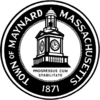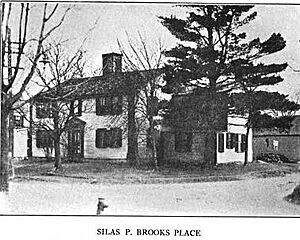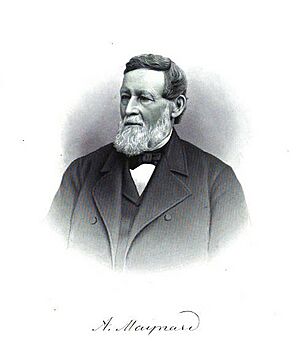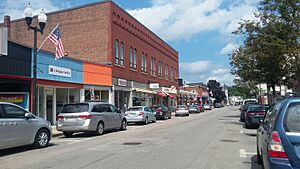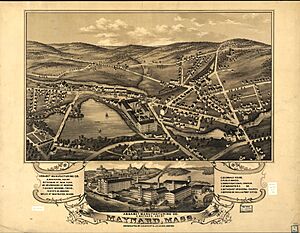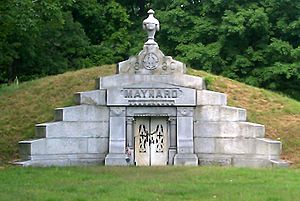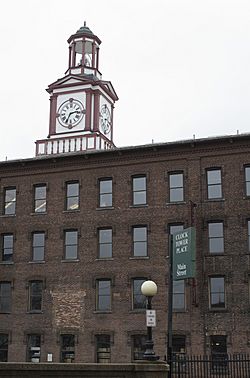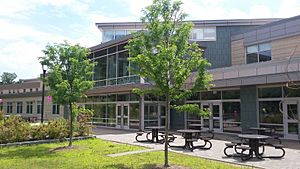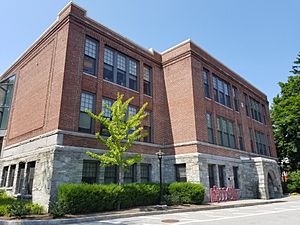Maynard, Massachusetts facts for kids
Quick facts for kids
Maynard, Massachusetts
|
||
|---|---|---|
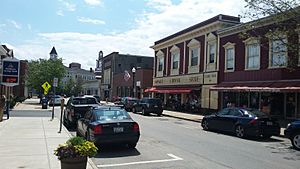
Nason Street in historic downtown Maynard
|
||
|
||
| Motto(s):
Progressus cum Stabilitate (Latin)
"Progress with Stability" |
||
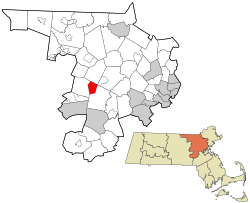
Location in Middlesex County in Massachusetts
|
||
| Country | United States | |
| State | Massachusetts | |
| County | Middlesex | |
| Settled | 1638 | |
| Incorporated | 1871 | |
| Government | ||
| • Type | Open town meeting | |
| Area | ||
| • Total | 5.4 sq mi (13.9 km2) | |
| • Land | 5.2 sq mi (13.6 km2) | |
| • Water | 0.1 sq mi (0.3 km2) | |
| Elevation | 186 ft (57 m) | |
| Population
(2020)
|
||
| • Total | 10,746 | |
| • Density | 2,066.54/sq mi (790.15/km2) | |
| Time zone | UTC−5 (Eastern) | |
| • Summer (DST) | UTC−4 (Eastern) | |
| ZIP Code |
01754
|
|
| Area code(s) | 351/978 | |
| FIPS code | 25-39625 | |
| GNIS feature ID | 0618229 | |
| Website | www.townofmaynard-ma.gov | |
Maynard is a town in Middlesex County, Massachusetts, in the United States. It's about 22 miles west of Boston. Maynard is part of the MetroWest and Greater Boston areas. It shares borders with Acton, Concord, Stow, and Sudbury. In 2020, about 10,746 people lived here.
Maynard is located along the Assabet River. This river flows into the Concord River. A big part of the Assabet River National Wildlife Refuge is in Maynard. The Assabet River Rail Trail connects the refuge and downtown Maynard to the South Acton train station. Downtown Maynard has many shops, restaurants, and a movie theater. It's also home to the old Assabet Woolen Mill. This mill made wool fabrics from 1846 to 1950. It even made cloth for Union Army uniforms during the Civil War. From 1957 to 1998, Digital Equipment Corporation (DEC) had its main office in Maynard. Today, the old mill building is rented out to many different businesses.
Contents
Maynard's Past: A Look at History
Maynard sits on the Assabet River. It was first settled by Puritan colonists in the 1600s. They bought the land from local Native American tribes. The tribes called the area Pompositicut or Assabet. In 1651, a Native American leader named Tantamous transferred land to Herman Garrett. Later, in 1684, Tantamous's son, Peter Jethro, and others transferred more land to the settlers.
During King Philip's War in 1676, Native Americans gathered on Pompasitticut Hill. They planned an attack on Sudbury from there. People from what is now Maynard also fought in the American Revolutionary War. For example, Luke Brooks from Summer Street joined the Stow militia. He marched to Concord on April 19, 1775.
In 1851, the famous writer Henry David Thoreau walked through the area. He wrote about it in his journal. He also published a poem about Old Marlboro Road. Part of this road runs through Maynard. During the American Civil War, at least 36 people from Assabet Village fought for the Union.
The area was first known as "Assabet Village." It was part of the towns of Stow and Sudbury. In 1871, Maynard became its own independent town. This happened after a petition was filed on January 26, 1871. The state approved it on April 19, 1871. The new town paid Sudbury and Stow for the land. Maynard's population was 1,820, which was larger than its parent towns.
New towns were often formed from older ones. This happened when a fast-growing area, usually around mills, was too far from the main town's schools and churches.
The town was named after Amory Maynard. He and William Knight bought water rights to the Assabet River. They built a large carpet mill there in 1846–1847. The community grew around the Assabet Woolen Mill. This mill made wool cloth for U.S. military uniforms during the Civil War. Downstream, the American Powder Mills made gunpowder from 1835 to 1940.
The woolen mill went out of business in 1898. In 1899, the American Woolen Company bought it. They modernized and expanded the mill from 1900 to 1919.
In 1902, some people tried to change the town's name to "Assabet." They were unhappy with Amory Maynard and his son. But the state decided to keep the name "Maynard."
In the early 1900s, Maynard was more modern than nearby areas. People would visit Maynard to shop. Even baseball legend Babe Ruth came to Maynard. He lived in nearby Sudbury during the off-season. He would visit Maynard to buy cigars and play pool. The town had a train station, an electric trolley, hotels, and movie theaters.
In 1942, the U.S. Army took a large part of the town's land. They used it to store military supplies. Landowners had to leave their homes. This land remained military property for many years. In 2005, it became part of the Assabet River National Wildlife Refuge.
After the woolen mill closed in 1950, a group of businessmen bought it. They started renting out space for offices and factories. Digital Equipment Corporation (DEC) moved into the complex in 1957. They started with a small space. DEC grew so much that it bought the whole complex in 1974. This led to Maynard's nickname: "Mini Computer Capital of the World." DEC stayed in Maynard until 1998. Then it was bought by Compaq, and later by Hewlett-Packard.
Locals call the old mill "The Mill." It was renovated and renamed "Clock Tower Place" in 2000. In 2016, new owners renamed it "Mill & Main Place." Many businesses are there now, including Powell Flutes. The mill complex also has the oldest working hand-wound clock in the country. The clock tower was built in 1892 by Lorenzo Maynard. The clock is wound once a week. This takes one to two hours. The four clock faces have always been lit by electric lights.
Glenwood Cemetery was started in 1871. It's south of downtown Maynard. It was added to the National Register of Historic Places in 2004. About 7,000 people are buried there.
The Maynard Family: Founders of the Town
John Maynard came from England around 1635. Five generations later, Isaac Maynard ran a mill in Marlborough. When he died, his son, Amory Maynard, took over. In 1846, the City of Boston bought Amory's water rights. He then partnered with William Knight to start a woolen mill on the Assabet River.
Amory Maynard and his wife, Mary, had three sons: Lorenzo, William, and Harlan. Amory managed the mill from 1847 to 1885. Lorenzo took over from 1885 to 1898. Harlan died young at age 18.
The Maynard Crypt is a large tomb in Glenwood Cemetery. It's a big mound with a granite front. Amory Maynard, his wife, and many of their family members are buried there.
Maynard's Location and Natural Features
Maynard covers about 5.4 square miles (13.9 km2). Most of this is land, with a small amount of water. The town's average height is about 200 feet (61 m) above sea level. The highest point is Summer Hill, at 358 feet (109.1 m). The lowest point is by the Assabet River, at 145 feet (44.2 m).
The Assabet River flows through Maynard from west to east. Seven road bridges and one footbridge cross the river. The river's drop in height helps power the old mills. The average water flow is about 200 cubic feet per second (5.7 m3/s). During dry summers, it can drop to under 100 cubic feet per second (2.8 m3/s).
Maynard borders Acton, Sudbury, and Stow. The town also owns water rights to White Pond. This pond is about three miles south of Maynard.
Getting Around Maynard
The closest train station is in South Acton. It's on the MBTA Commuter Rail Fitchburg Line. This station is about 1 mile (1.6 km) from Maynard. An express train takes about 30 minutes to Porter Square in Cambridge. It takes about 45 minutes to North Station in Boston. By car, Route 2 is 4 miles (6 km) from downtown Maynard. I-95 and I-495 are both about 8 miles (13 km) away.
The Assabet River Rail Trail was finished in September 2018. It is 3.4-mile (5.5 km) long. It runs from the South Acton train station, through Maynard, and along the Assabet River. It goes to the Maynard:Stow border. From there, you can reach the Assabet River National Wildlife Refuge. The trail is for walking, biking, and rollerblading.
Maynard's Population: Who Lives Here?
| Historical population | ||
|---|---|---|
| Year | Pop. | ±% |
| 1880 | 2,291 | — |
| 1890 | 2,700 | +17.9% |
| 1900 | 3,142 | +16.4% |
| 1910 | 6,390 | +103.4% |
| 1920 | 7,086 | +10.9% |
| 1930 | 7,156 | +1.0% |
| 1940 | 6,812 | −4.8% |
| 1950 | 6,978 | +2.4% |
| 1960 | 7,695 | +10.3% |
| 1970 | 9,710 | +26.2% |
| 1980 | 9,590 | −1.2% |
| 1990 | 10,325 | +7.7% |
| 2000 | 10,433 | +1.0% |
| 2010 | 10,106 | −3.1% |
| 2020 | 10,746 | +6.3% |
| Source: United States Census records and Population Estimates Program data. | ||
In 2020, Maynard had 10,746 residents. This was a 6.3% increase from 2010. There were 4,262 households, with about 2.52 people per household. The population density was about 1,938 inhabitants per square mile (748/km2).
About 7.6% of the population was under 5 years old. About 21.6% was under 18 years old. And 15.2% was 65 years or older. The median income for a household was $105,254.
Most residents (92.4%) were White. Other groups included Black (1.3%), Asian (1.7%), and people of two or more races (1.7%). Hispanic or Latino people made up 3.4% of the population.
Learning in Maynard: Schools and Education
Maynard has three public schools. They are all on campuses next to each other, off Route 117. There is also a program for adult education. One private school offers a Christian education program for younger students.
- Green Meadow School: This school is for grades Pre-K through 3.
- Fowler School: This school serves grades 4 through 8.
- Maynard High School: This school is for grades 9 through 12. The current building opened in 2013.
- Hudson Maynard Adult Learning Center: Offers free classes for adults. These include English for speakers of other languages (ESOL) and GED preparation.
- The Imago School: Teaches grades K through 8. It is a classical Christian education program.
Places of Worship in Maynard
Maynard has several places of worship for different faiths:
- Baha'i Faith Devotional Meetings
- First Bible Baptist Church
- Holy Annunciation Orthodox Church
- Kingdom Hall of Jehovah's Witnesses
- New Hope Fellowship Church of the Nazarene
- St. Bridget Roman Catholic Church
- St. Mary's Indian Orthodox Church
- St. Stephen's Knanaya Church
Fun Things to See and Do in Maynard
- Acme Theater Productions: A non-profit community theater company.
- Fine Arts Theatre Place: A movie theater with three screens. It shows new movies and classic films.
- Glenwood Cemetery: A historic cemetery established in 1871. You can take a self-guided walking tour here. It also contains the Maynard family crypt.
- Maynard Public Library: Established in 1881. It moved to its current location on Nason Street in 2006.
- Presidential district/New Village: A neighborhood built in 1902–1903 for mill workers. The streets are named after U.S. Presidents.
Outdoor Activities and Recreation
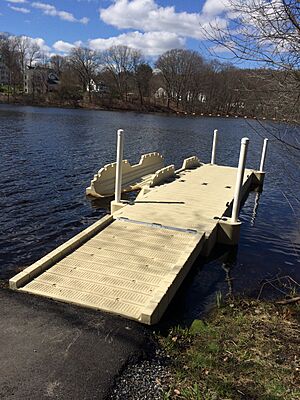
- Alumni Field: Has tennis courts and a track for running. It's open to everyone.
- Assabet River Rail Trail: A paved trail for walking, biking, and rollerblading. It connects to the Assabet River National Wildlife Refuge.
- Assabet River National Wildlife Refuge: Established in 2000. This large area offers hunting, fishing, and 15 miles (24 km) of trails. It was once a military storage facility.
- Boating and fishing: You can canoe and kayak on the Assabet River. There are launch docks available.
- Crowe Park: A baseball and recreation field.
- Maynard Dog Park: A fenced area where dogs can play off-leash. It's free for residents and visitors.
- Hiking trails and open spaces: The town has maps of public trails, including on Summer Hill.
- Historic Walking Tours: You can download maps for six self-guided walking tours of Maynard.
- Maynard Golf Course: A nine-hole golf course. It was bought by the town in 2012.
- Maynard Rod and Gun Club: Offers ranges for shooting, archery, and a fishing pond.
Famous People from Maynard
- Julie Berry: An author who writes books for children and young adults.
- Luke Brooks (1731–1817): A minuteman who fought in the Battle of Lexington during the Revolutionary War.
- Elizabeth Updike Cobblah: An artist and daughter of famous author John Updike.
- John "Red" Flaherty (1917–1999): Born in Maynard, he was a baseball umpire in the American League.
- Michael Goulian: A famous airshow performer and pilot.
- Herb Greene: A well-known photographer, especially of the band Grateful Dead.
- Waino Kauppi: A child prodigy who played the cornet.
- Amory Maynard (1804–1890): Started the woolen mill in 1846. The town is named after him.
- Leo Mullin: Former CEO of Delta Airlines. He was born and grew up in Maynard.
- Frank Murray (1885–1951): Born in Maynard, he was a college football coach and is in the College Football Hall of Fame.
- Ken Olsen (1926–2011): Founder and president of Digital Equipment Corporation (DEC).
- Hermon Hosmer Scott (1909–1975): Founder of H.H. Scott, Inc., a Hi-fi company.
- Jarrod Shoemaker: A professional triathlete.
- Tantamous (Old Jethro) (c. 1580–1676): A Native American leader.
- William G. Tapply (1940–2009): An author who lived in Maynard.
Maynard's Fun Events
- Maynard Fest: Held every fall since 1992. It's a big community celebration.
- Maynard Christmas Parade: A festive parade held every year since 1966.
- Maynard Farmers Market: Takes place on Main Street next to the Mill. You can visit it on Saturdays from June to October. It started in 1996.
See also
 In Spanish: Maynard (Massachusetts) para niños
In Spanish: Maynard (Massachusetts) para niños


